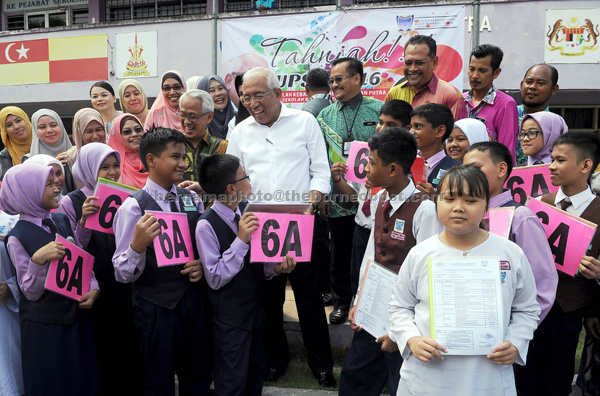
Mahdzir (centre) with the students who achieved straight A’s in Ujian Pencapaian Sekolah Rendah (UPSR) at Sekolah Kebangsaan Bukit Rahman Putra in Kuala Lumpur. — Bernama photo
KUALA LUMPUR: The results of this year’s Ujian Pencapaian Sekolah Rendah (UPSR) examination which uses a new format should be seen in a more holistic manner, and not focus on purely academic questions, said Education Minister Datuk Seri Mahdzir Khalid.
According to him, this was because the examination this time was more focused on a creative approach and high-level thinking than last year which utilised multiple-choice questions.
“In the examination this year, the total number of ‘As’ is for six subjects. So parents need not worry about the number of A’s. Of course getting an ‘A’ is very good, but overall it is a different format from last year’s,” Mahdzir said.
He was speaking to reporters after visiting Sekolah Kebangsaan Bukit Rahman Putra, Sungai Buloh, near here in conjunction with the announcement of the UPSR 2016 results yesterday.
He stressed that the UPSR results this year should not be compared to last year’s as pupils had to answer examination papers with a better understanding and require basic writing skills compared to the previous objective format.
Mahdzir said the UPSR 2016 saw the first group using the new format implemented under the Kurikulum Standard Sekolah Rendah (KSSR) which also complements the School-Based Assessment (SBA) since 2011.
Education director-general Tan Sri Dr Khair Mohamad Yusof today announced in Putrajaya that 4,896 out of 452,721 students obtained grade A in all the subjects in UPSR 2016.
This year, he said, students will receive four examination result slips, namely the UPSR Results slip, School Assessment slip, Psychometric Assessment Assessment slip and Physical Assessment and Co-curricular slip.
Khair said that as for the achievement gap between urban and rural areas, the average grade was 2.84 per cent for urban areas while for rural areas it was 3.08 percent. — Bernama
